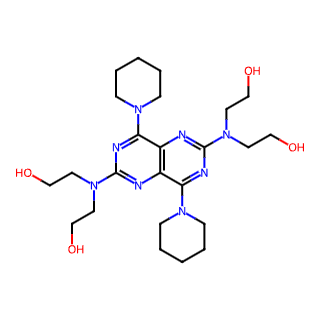- Synthetic anti-infective drugs
- Medications for the digestive system
- Antipyretic and analgesic drugs
- Medications for the blood system
- Medications for the respiratory system
- Anti-allergic drugs
- Medications for the urinary system
- Diagnostic medications
- Immunosuppressive and immunomodulatory drugs
- Vitamins and mineral supplements
- Antioxidants and medications for osteoporosis
- Antiparasitic drugs
- Ophthalmic medications
- Amino acids and their derivatives
- Dermatological medications
- Medications for the circulatory system
- Antitumor drugs
- Medications for the nervous system
- Hormonal and endocrine function-regulating drugs
- Antibiotics
- Others
CAS NO.: 58-32-2




Basic Information
Chinese Name: 双嘧达莫
English Name: Dipyridamole
CAS Number: 58-32-2
Molecular Formula: C24H40N8O4
Molecular Weight: Approximately 504.63 (specific values may vary slightly between sources, but generally range from 504.6256 to 504.63)
Physical and Chemical Properties
Melting Point: Approximately 163°C to 166°C (values may vary slightly between sources).
Solubility: Easily soluble in chloroform and dilute acids, soluble in ethanol, slightly soluble in acetone, practically insoluble in water. Solutions appear yellow and may exhibit intense blue-green fluorescence.
Density: Approximately 1.4±0.1 g/cm³ (or 1.352, specific values may vary depending on conditions).
Boiling Point: 806.5°C at 760 mmHg.
Flash Point: 441.5°C.
Safety and Hazards
Safety Statements: S26 (In case of contact with eyes, rinse immediately with plenty of water and seek medical advice); S36 (Wear suitable protective clothing).
Hazard Symbols: Xi (Irritant).
Risk Phrases: R36/37/38 (Irritating to eyes, respiratory system, and skin).
Uses
Dipyridamole (CAS NO.: 58-32-2) is primarily used as a coronary vasodilator in the treatment of cardiovascular diseases such as angina pectoris and myocardial infarction. As a phosphodiesterase inhibitor, it blocks the absorption and metabolism of adenosine by red blood cells and vascular endothelial cells, thereby exerting its pharmacological effects.
In conclusion, Dipyridamole (CAS NO.: 58-32-2) is an important pharmaceutical raw material and cardiovascular treatment drug with broad application prospects and market value.

Tai Yau Street, San Po Kong, Kowloon, Hong Kong, China.



